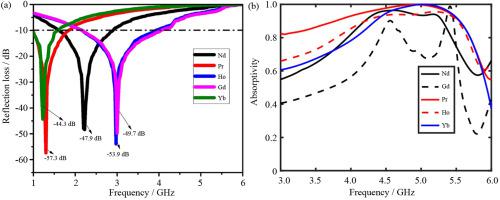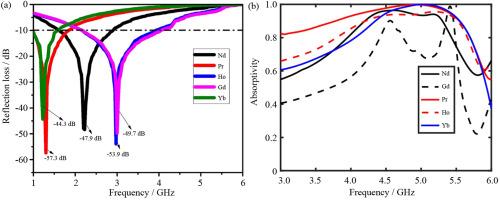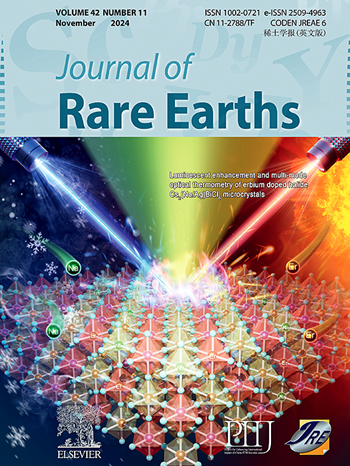用于 C 波段应用的可调谐宽带高性能掺稀土镍镁铜锌纳米铁氧体元吸收体
IF 7.2
1区 化学
Q1 CHEMISTRY, APPLIED
引用次数: 0
摘要
随着技术的发展,电子和便携设备在 GHz 范围内的电磁干扰和耗散问题与日俱增。具有优异电磁特性、宽频带和强吸收能力的磁性吸收材料非常受欢迎。本研究涉及镍镁铜锌(NMCZ)替代纳米铁氧体的制备,其组成为 Ni0.3Mg0.2Cu0.3Zn0.2X0.02Fe1.98O4 (X = Nd、Ho、Pr、Gd、Yb)。研究人员使用了 X 射线衍射 (XRD)、傅立叶变换红外光谱 (FTIR)、场发射扫描电子显微镜 (FESEM)、透射电子显微镜 (TEM)、振动样品磁力计 (VSM) 和矢量网络分析仪 (VNA) 来研究这些掺稀土的纳米晶铁氧体的特征。XRD 揭示了所有镍镁铜锌铁氧体的单一尖晶石相结构。傅立叶变换红外光谱显示尖晶石铁氧体存在四面体和八面体带。FESEM 图像显示,掺杂 Ho 的 NMCZ 纳米尖晶石铁氧体样品的团聚程度最低。TEM 图像显示掺镱和掺钕的 NMCZ 铁氧体呈六边形。与其他稀土金属取代的 NMCZ 纳米晶铁氧体相比,掺杂 Pr 的 NMCZ 铁氧体显示出更高的矫顽力。VSM 分析用于计算初始磁导率、磁各向异性常数、剩磁、矫顽力和磁矩等磁性特征。此外,还研究了高频开关场分布(SFD)分析。还评估了掺钕-、掺氦-、掺镨-、掺钆-、掺镱-镍镁铜锌铁氧体的磁电特性,如损耗、介电常数、模量、Q 值、交流电导率和阻抗。发现掺镨镍镁铜锌铁氧体吸收器在 1.4 GHz 时的反射损耗(-57.3 dB)最小。然而,掺杂 Ho 的镍镁铜锌铁氧体吸收器在 2.9 GHz 时的反射损耗(RL)为 -53.9 dB。掺杂 Ni-Mg-Cu-Zn、Ho-、Pr-、Gd- 和 Yb 的铁氧体具有软磁化、低矫顽力、出色的磁介电和吸收特性,适合用于电信、国防和技术行业的吸收。本文章由计算机程序翻译,如有差异,请以英文原文为准。


Tunable and wideband high-performance rare earth-doped Ni-Mg-Cu-Zn nano ferrite-based meta-absorbers for C-band application
Due to advanced technology, electromagnet interference and dissipation problems in the electronic and portable devices at GHz range are increasing daily. Magnetic absorbing materials with outstanding electromagnetic properties, wide bandwidth, and strong absorption are highly desirable. The present investigation deals with the preparation of Ni-Mg-Cu-Zn (NMCZ) substituted nano ferrites with composition of Ni0.3Mg0.2Cu0.3Zn0.2X0.02Fe1.98O4 (X = Nd, Ho, Pr, Gd, Yb). X-ray diffraction (XRD), Fourier transform infrared spectroscopy (FTIR), field emission scanning electron microscopy (FESEM), transmission electron microscopy (TEM), a vibratory sample magnetometer (VSM), and a Vector network analyzer (VNA) were used to investigate these rare earth-doped nanocrystalline ferrites' features. XRD reveals the single spinel phase structure in all Ni-Mg-Cu-Zn ferrites. FTIR spectroscopy shows the presence of tetrahedral and octahedral bands of spinel ferrites. FESEM images reveal the lowest agglomeration for the Ho-doped NMCZ nano-spinel ferrites sample. TEM images show the hexagon shapes of the Yb- and Nd-doped NMCZ ferrites. Pr-doped NMCZ ferrites show more coercivity than other rare earth metals substituted NMCZ nanocrystalline ferrites. VSM analysis was used to calculate the magnetic features like initial permeability, magnetic anisotropy constant, remanence, coercivity, and magnetic moment. High-frequency switching field distributions (SFD) analyses were also investigated. Magnetodielectric characteristics such as losses, permittivity, modulus, Q, ac conductivity, and impedance of the Nd-, Ho-, Pr-, Gd-, Yb-doped Ni-Mg-Cu-Zn ferrites were evaluated. The minimum reflection loss (–57.3 dB) is found at 1.4 GHz for Pr-doped Ni-Mg-Cu-Zn ferrite absorber. However, the reflection loss (RL) of –53.9 dB at 2.9 GHz is observed for Ho-doped Ni-Mg-Cu-Zn ferrite absorber. Soft magnetization, low coercivity, outstanding magnetodielectric, and absorption properties of the Nd-, Ho-, Pr-, Gd- and Yb-doped Ni-Mg-Cu-Zn ferrites are suitable candidates for absorption in telecommunication, defense, and technological industries.
求助全文
通过发布文献求助,成功后即可免费获取论文全文。
去求助
来源期刊

Journal of Rare Earths
化学-应用化学
CiteScore
8.70
自引率
14.30%
发文量
374
审稿时长
1.7 months
期刊介绍:
The Journal of Rare Earths reports studies on the 17 rare earth elements. It is a unique English-language learned journal that publishes works on various aspects of basic theory and applied science in the field of rare earths (RE). The journal accepts original high-quality original research papers and review articles with inventive content, and complete experimental data. It represents high academic standards and new progress in the RE field. Due to the advantage of abundant RE resources of China, the research on RE develops very actively, and papers on the latest progress in this field emerge every year. It is not only an important resource in which technicians publish and obtain their latest research results on RE, but also an important way of reflecting the updated progress in RE research field.
The Journal of Rare Earths covers all research and application of RE rare earths including spectroscopy, luminescence and phosphors, rare earth catalysis, magnetism and magnetic materials, advanced rare earth materials, RE chemistry & hydrometallurgy, RE metallography & pyrometallurgy, RE new materials, RE solid state physics & solid state chemistry, rare earth applications, RE analysis & test, RE geology & ore dressing, etc.
 求助内容:
求助内容: 应助结果提醒方式:
应助结果提醒方式:


